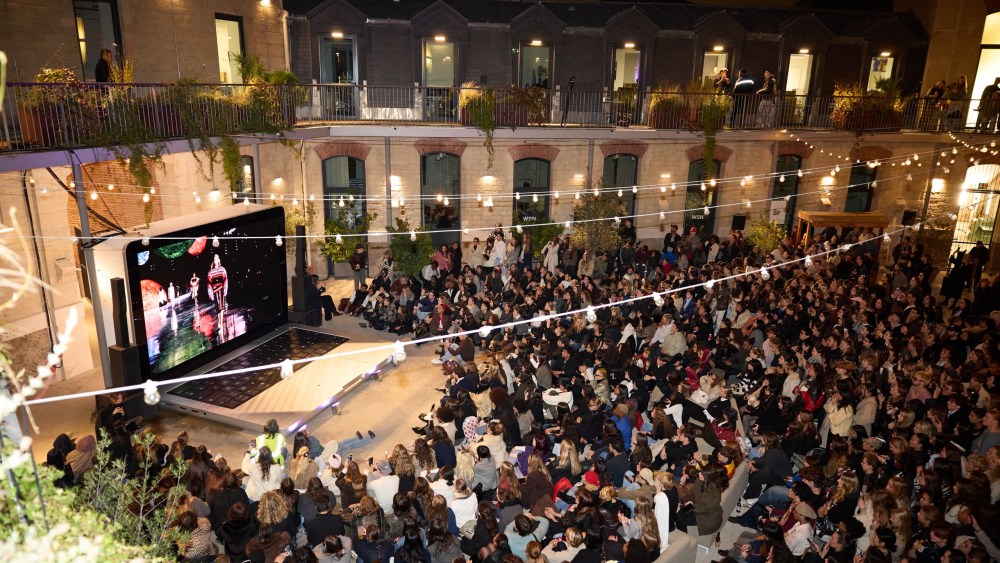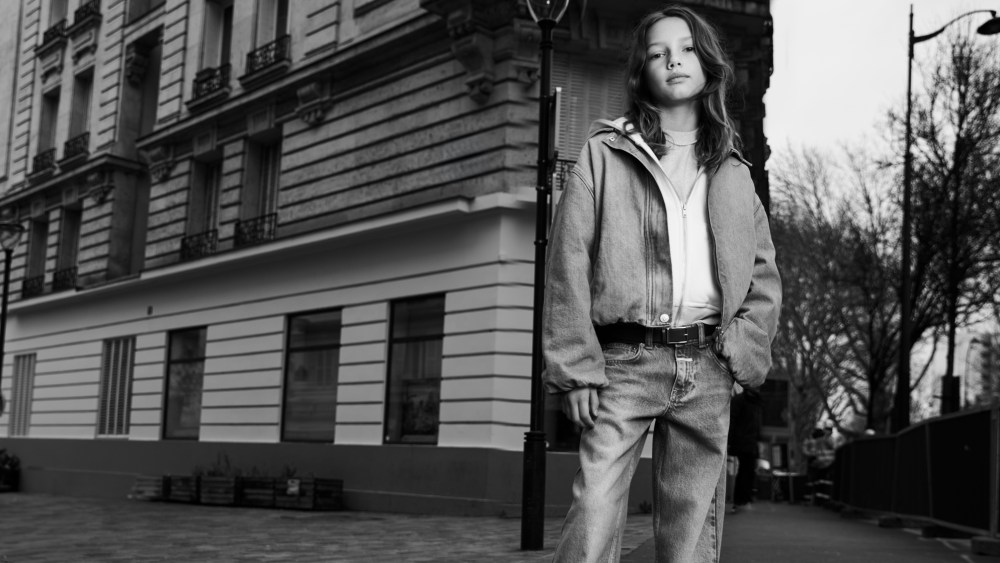PARIS — As the fashion industry hands the reins to a new generation of designers, the role of fashion critic is rapidly evolving, too.
Once restricted to an elite group of editors sitting in the front row at runway shows, critiquing collections has become a spectator sport, with millions delivering instant verdicts online. That has triggered a lively debate about the impact of free speech in a business known for meticulous image control.
In Paris, fashion-show watch parties organized by self-described “fashion agitator” Lyas drew more than 13,000 people to sustainable fashion accelerator hub La Caserne.
Preceded by events in London and Milan, his eight-day La Watchparty festival featured livestreams from brands including Dior, Chanel, Saint Laurent, Courrèges and Balenciaga on a giant laptop screen. Participants were given QR codes to assign a rating to each show, with audience members invited on stage to discuss their opinion.
You May Also Like
“These days, anyone can take on the role of commentator, critic, or even journalist — that’s what I did,” Lyas told WWD.
The content creator, whose real name is Elias Medini, is part of a new wave of social commentators offering candid takes on fashion month, which saw a record 15 designer debuts this season, opening the floodgates for hot takes and community engagement.

The spring 2026 season was the most anticipated and impactful to date, driving a record $881 million in earned media value, up 5 percent year-on-year, according to a report by Karla Otto, Lefty and CTZAR, all partner agencies under the umbrella of The Independents.
Of this, $9.7 million was driven by social commentators who are either being welcomed at the shows or are creating content at the sidelines. They include Luke Meagher, the creator of Instagram account Hautelemode, Australian stylist Kim Russell, aka The Kimbino, and Ideservecouture’s Hanan Besovic.
“They are loved by their audiences for their distinctive, non-filtered opinion. In a world where we face constant information overload, audiences are valuing individualism and this is something fashion commentators provide in abundance,” said Lissy Von Schwarzkopf, global chief business officer at Karla Otto.
Medini, known for his signature bright red lipstick, threw an impromptu watch party at a Paris bar in June after failing to get an invitation for Jonathan Anderson’s debut menswear show for Dior, and was stunned when 350 people showed up. He was worried he might not be able to fill La Caserne, which has a capacity of 900, but ended up having to turn people away.
Crowds cheered the shows, creating a sense of community that is missing when watching at home alone, he said. The festival produced by Kitty Events, another division of The Independents, featured refreshments, merchandise like a “How to Sneak Into a Fashion Show” T-shirt, and gifting from streamed brands such as Loewe.
While sponsors including Vinted and MAC Cosmetics covered the bulk of the cost, Medini personally contributed 100,000 euros to the budget.

“It’s important for the culture,” he reasoned. “I want people to come into a place and feel free to talk and debate and talk s–t if they want to, without having the idea that, ‘Oh, Dior is sponsoring this event, so I can’t.’ I want people to be able to have free drinks and free food, because I want to respect them. I don’t want them to feel like they’re not at the show, so they get a second-hand experience.”
For some shows, he gave away his invitation in a lucky draw. For others, he took a moto taxi from the watch party directly to the show and live-streamed the action behind the scenes. After the Chanel show, he returned to La Caserne with models Mona Tougaard and Loli Bahia, fresh off the runway.
“The aim is to open the doors to a new generation of enthusiasts who may feel excluded or unrepresented in fashion. God knows it was difficult for me to find my place in this industry, and I’m simply trying to make that path a little easier for others,” Medini said.
Lyas’ watch parties led to 34 million impressions and garnered $3.9 million in EMV across Instagram, TikTok, Xiaohongshu (Red) and X, according to Lefty. The event had an engagement rate of 13.5 percent, 13 times the average of the season.
‘A Troll Fest’
For designers, however, the democratization of fashion commentary can be a painful experience. Speaking a few days before his eagerly awaited womenswear debut for Dior, Anderson described the feeling of stepping into a gladiatorial arena.
“I have never been under more pressure in my entire life, and I’m usually the person who puts the pressure on, but this one is more complex, because it used to be that it was never more fashionable to like fashion. Now it’s more fashionable to destroy fashion,” he said. “Everyone has an opinion. It’s a lot of noise.”
Ruminating on his first year at the helm of Valentino, Alessandro Michele said he had to deal with haters and recurring rumors about his potential exit. “People like to gossip. Fashion has become pop, but the bar of the conversation has been tragically lowered,” he opined.
Michele said that while everyone has a right to express their opinion, he regrets the tone of public debate. “What I feel that is missing is the respect that is necessary in a conversation; we have become dangerously aggressive, arrogant and overbearing,” he said. “There can be a healthy dialogue even with different points of view, but grace and kindness are lost.”

Edward Buchanan, who was Bottega Veneta’s first design director in the 1990s, crystallized the debate with a public plea for commenters to dial down the bile. “Please bring some intelligent criticism to the table otherwise it’s just a troll fest from the comfort of your homes,” he wrote in an Instagram post that garnered more than 4,700 likes and almost 400 comments.
As the Milan-based fashion director for Perfect magazine, the creative director and cultural advocate said he was motivated to speak out because many of the comments target the individual, rather than their work.
“People can say whatever they want about however they feel. The internet is an open space and these young voices are absolutely necessary within this space,” he said. “I’ve just become increasingly unnerved with the personal attacks on designers, and I can’t say enough about really allowing development space for designers to actually do the work.”
Buchanan recalled that when he was appointed to launch ready-to-wear at Bottega Veneta, he had almost three years to develop the collection with an under-the-radar retail launch. He also questioned whether it was possible to judge a collection from images alone, and without knowledge of the techniques and history of fashion design.
“We want the space of fashion to be democratic, and we want everyone to be able to feel like they can be involved in it, but I think criticism has to be informed,” he argued. “There has to be a 360-degree understanding of what you’re talking about, otherwise it’s just words.”
Questioning the Critics
Berlin-based writer and influencer Brenda Weischer, aka Brendahashtag, said established media were partly to blame for the free-for-all.
“I think Edward’s concern is absolutely valid, it’s just that a lot of the ‘informed’ people or legacy media are a decade too late in building their platforms in order to inform the public. The reality is, a TikTok video review is more entertaining than a Vogue Runway review. And it’s been like this for years, so I am baffled with how media is not adapting,” she said.
“They could have hired the big commentators and provided them with the missing knowledge in order to create informed yet entertaining fashion content, but instead they ignored them, hoping they’d go away,” said Weischer, noting there are a handful of exceptions such as 032c magazine, where she is a contributor.

Benjamin Simmenauer, professor and director of research at the Institut Français de la Mode in Paris, also believes that online critics are reacting to a system they don’t trust.
“When the public perceives official reviews as too soft or not entirely objective, they step in to fill that gap,” he said. “When it comes to major fashion houses, truly negative reviews are rare. That’s partly because the pressure these big brands exert on the press — both human and economic — is considerable. It’s difficult for journalists to express even a mildly critical opinion about a major collection.”
He added that fashion’s move into entertainment has also blurred the perception of runway shows.
“Image has become so important that it’s hardly surprising we no longer think of fashion primarily as products to be consumed, but rather as images to be experienced. Perhaps it’s time to imagine brands’ social media platforms as paid channels, much like Netflix,” he said.
But with luxury spending showing only tentative signs of recovery, the key challenge for designer labels is turning online chatter into purchases.
“There is this almost ironic movement of having more eyeballs than ever on what is happening at fashion week, meanwhile the industry is generally in a lot of trouble,” said Weischer. “I think this is something that the brands should be concerned with, rather than being worried about mean or false commentary: how to convert critics into customers.”
She said that after witnessing Virgil Abloh invite 700 design school students to his debut collection as menswear designer for Louis Vuitton in 2018, she naturally assumed that inclusivity would become common practice.
“I don’t understand why it’s so difficult to think of that,” Weischer said, noting that brands still draw paltry viewing figures for their show streams on Instagram. “If you got someone like Emma Chamberlain to lead you through the livestream, I am sure more people would watch.”
In the meantime, Lyas is already thinking about how to bring his watch parties to an even bigger audience next season.
“The goal is to take it global. I think there’s a before and an after, for sure, in this industry. People longed for a space like this for so long,” he said. “It’s the first seed of something way bigger, because there’s huge potential to that idea, and with the right sponsors, I’m sure we can do something great without me ruining myself.”


